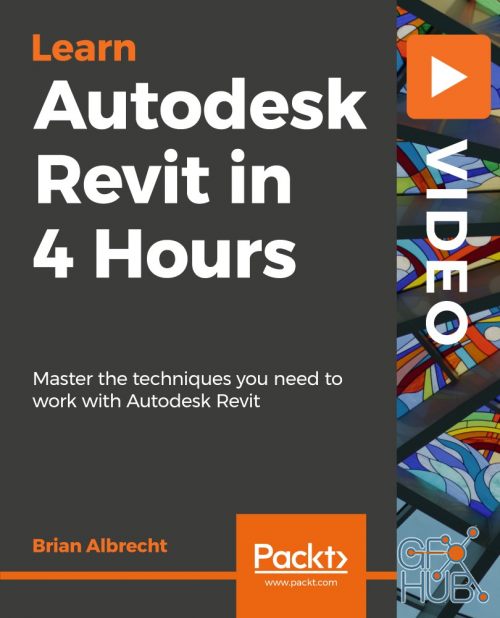Packt Publishing – Autodesk Revit in 4 Hours
Autodesk Revit boasts powerful tools that allow you to efficiently plan and manage your projects and visualize your designs.

You will begin by moving around in Revit before discussing the tools you'll need to begin setting up a project. Then you'll cover the basic tools and methods for building a 3D model using all of the most common tools. Then you will create custom elements that allow you to add a level of detail and design to make your projects unique.
You will then learn 2D modeling; we will be looking at many of the tools that help round-out a good drawing set; from dimensions, to two-dimensional linework and fill regions—everything from the stock materials built into Revit, to creating custom textures to get the look you’re after. After learning 2D models you will create 3D views, all of the settings that are associated with the internal rendering engine
Finally, we will discuss tools and processes by which you can produce a full construction document or presentation drawing set; this will include title blocks, sheets, and custom schedules, as well as how to save a set of drawings as a PDF or print them as hard copies.
What You Will Learn
The basic tools required to build a 3D model.
The tools needed to build custom and unique elements to set your model apart.
The tools you'll need for detailing and dimensioning your construction and shop drawing projects.
Loading, modifying, and creating custom materials to make your model look its best when it comes to rendering and document production.
Tips and tricks for lighting a model to achieve the best rendering you can.
Tools for the production of drawing sets, including the use of title blocks, schedules, and various view types
The basics of creating fully parametric families to build your very own content library.
953MB
Download
*
Autodesk Revit boasts powerful tools that allow you to efficiently plan and manage your projects and visualize your designs.

You will begin by moving around in Revit before discussing the tools you'll need to begin setting up a project. Then you'll cover the basic tools and methods for building a 3D model using all of the most common tools. Then you will create custom elements that allow you to add a level of detail and design to make your projects unique.
You will then learn 2D modeling; we will be looking at many of the tools that help round-out a good drawing set; from dimensions, to two-dimensional linework and fill regions—everything from the stock materials built into Revit, to creating custom textures to get the look you’re after. After learning 2D models you will create 3D views, all of the settings that are associated with the internal rendering engine
Finally, we will discuss tools and processes by which you can produce a full construction document or presentation drawing set; this will include title blocks, sheets, and custom schedules, as well as how to save a set of drawings as a PDF or print them as hard copies.
What You Will Learn
The basic tools required to build a 3D model.
The tools needed to build custom and unique elements to set your model apart.
The tools you'll need for detailing and dimensioning your construction and shop drawing projects.
Loading, modifying, and creating custom materials to make your model look its best when it comes to rendering and document production.
Tips and tricks for lighting a model to achieve the best rendering you can.
Tools for the production of drawing sets, including the use of title blocks, schedules, and various view types
The basics of creating fully parametric families to build your very own content library.
953MB
Download
*

